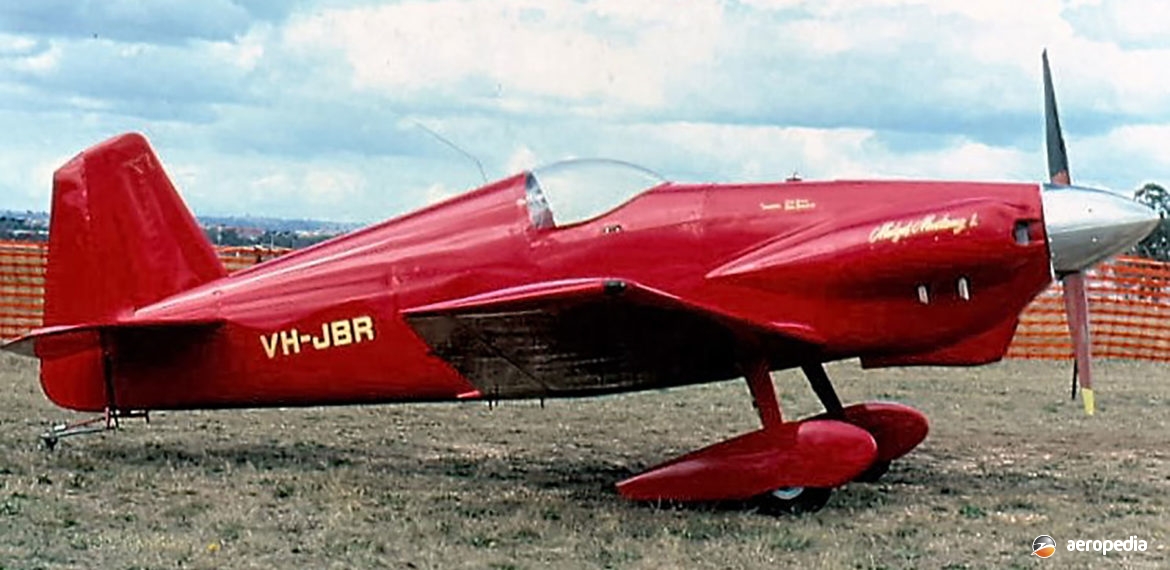Photograph:
Bushby Mustang I VH-JBR (c/n V66) at Mangalore, VIC in April 1984 (David C Eyre)
Country of origin:
United States of America
Description:
Single-seat fully-aerobatic sport monoplane
Power Plant:
One 101 kw (135 hp) Lycoming O-290-D2 four-cylinder horizontally-opposed air-cooled engine
Specifications:
- Wingspan: 5.64 m (18 ft 6 in)
- Length: 5 m (16 ft 5 in)
- Height: 1.37 m (4 ft 6 in)
- Wing area: 6.32 m² (68 sq ft)
- Max speed at sea level: 362 km/ (225 mph)
- Max cruising speed at 2,440 m (8,000 ft): 346 km/h (215 mph)
- Economical cruising speed: 266 km/h (165 mph)
- Max rate of climb: 670 m/min (2,200 ft/min)
- Stalling speed flaps down: 97 km/h (60 mph)
- Service ceiling: 5,790 m (19,000 ft
- Range with max fuel: 603 km (375 miles)
- Range with max fuel and wing-tip tanks: 1,200 km (750 miles)
- Empty weight: 268 kg (590 lb)
- Loaded weight: 408 kg (900 lb)
History:
The Bushby Mustang I was designed by the late David Long, and was originally known as the Midget Mustang, being of all-metal construction, the prototype flying for the first time in 1948. It took part in the National Air Races in the United States in 1949. At that time Mr Long was the chief engineer of Piper Aircraft, and in the prototype he gained fourth place in the Continental Trophy Race in Miami in Florida.
Robert Bushby built a Midget Mustang using drawings, jigs and certain components produced by the designer, and subsequently produced the type in kit form and made available sets of plans. Two basic versions were produced by Bushby, the MM-1-85 with a 63 kw (85 hp) Continental engine, the first of which flew on 9 September 1959; and the MM-1-125 with a 101 kw (135 hp) Lycoming engine, which first flew in July 1963.
The type proved popular, and examples have been built around the world with engines ranging up to the 112 kw (150 hp) Lycoming O-320, this providing a cruising speed at 2,440 m (8,000 ft) of 435 km/h (270 mph). A few have been fitted with a retractable undercarriage, but the norm has been a fixed undercarriage.
The wing was a two-piece cantilever structure consisting of flanged aluminium ribs and two folded metal spars with reinforcing booms, aluminium covered. Flaps and ailerons were all-metal. The fuselage was of stressed skin semi-monocoque structure of elliptical cross-section. The tail unit was all-metal and incorporated a bungee elevator trim. The undercarriage was two spring-steel legs and a steerable tailwheel. A 54.5 litre (12 Imp gals) fuel tank was installed, and provision was made for 5.5 kg (12 lb) of baggage.
First of the type seen in Australia was the bright red with gold trim VH-JBR (c/n V66) first registered in 1985. Since then further examples have been completed and registered.
Examples completed in New Zealand have included ZK-DDC (c/n AACA/107), ZK-CCG² (c/n AACA465), ZK-CWO (c/n AACA11/1), ZK-DFN (c/n AACA111-1), ZK-EDP (c/n 144/1), ZK-JFH (c/n 1032 – ntu), ZK-MFE (c/n 2036), ZK-MMC (c/n 946) and ZK-ZLB (c/n 957).

